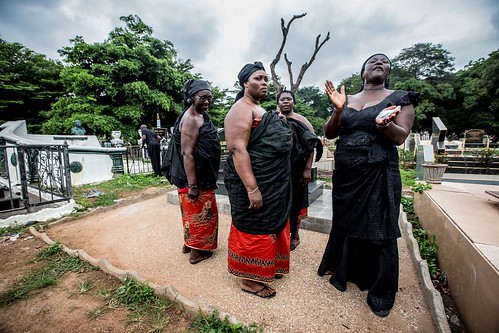
The Asantes (Ashantis) are traditional strict observers of Akan civilisation as well as as they are noted for "they don`t do things yesteryear halves." When Asantes do things they do it to the fullest, abhor it or similar it, that who they are! They are genuinely a people of civilisation as well as they are worthy ambassadors of rich Akan civilisation as well as traditions.
One of the Akan civilisation that Asantes do non joke alongside with is their funerals. They are good known for their strict observance as well as cooperation during funeral to commemorate the deceased as well as they unique lawsuit that takes topographic point after the burial.

Wife displaying items she has brought to celebrate the decease of her mother in law at a funeral inwards Kumasi. The items are what the women are carrying their heads
Like every culture, Asantes celebrate the transition of the soul of the deceased, into the ancestral world where it becomes a protective spirit for the clan, as a final result the dead somebody is highly venerated through funeral celebrations. Family, friends as well as acquaintances, sometimes inwards their hundreds, take component inwards the celebrations. The participants wearing clothing inwards accordance alongside tradition, the wearing clothing worn yesteryear relatives is inwards cerise piece the others have on dark stuff as well as every slice of gilded jewelry their bodies tin support. There are many rituals: giving offerings to the spirits of the ancestors, food, drinks, traditional dances accompany him inwards the world of the ancestors inwards a flurry of drumming as well as wild dancing.

Asante traditional rulers greeting at a funeral inwards Kumasi, Ashanti Region, Ghana. Courtesy
Anthony Pappone
To the Asantes, funeral is similar a festival of a kind to them. They hardly have got festival except their Odwira festival of the Asantehene. Funeral ceremonies are non only a fourth dimension of mourning to them but also a festive occasion as well as an avenue for coming together long lost friends as well as family. As a final result of these funerals has go a serious employment organisation as well as social gathering that no Asante wishing to miss at the weekends. Every amount of coin is pass to celebrate a funerals inwards Ashanti Region.
Guests at funeral greeting i some other at a funeral inwards Kumasi. Courtesy Anthony Pappone
Professor Kwabena Nketia, the cracking Ghanaian as well as international musicologist as well as living African traditional scholar par excellence writing inwards the 1950 concerning the unchanging lavish display at Akans funerals averred: "The celebration of funeral is regarded as duty as well as no pains are spared to create it a memorable event. `Was it good attended?` (Ayie no nkrofuo bae?), `Was it exciting?` (Ayie no soe?) Those are the questions that may live asked as a attempt out of successful funeral (Nketia, 1954: 48)

Funeral celebration inwards Kumasi
Influenza A virus subtype H5N1 few years afterwards Field (1960:48) stressed the same point:"A funeral must ever live grand as well as expensive." But Dr J Danquah, the the celebrated "doyen of Gold Coast Politics," the first off African to gain doctorate grade from British University as well as i of the first off Western educated Ghanaian scholars, sounded a critical greenback when writing when describing Akan funeral customs. Here he inwards his 1927 writing he added a footnote to apologize to the reader:
"There is no concealing fact that the employment organisation human relationship of customs as here
presented would seem repulsive, perhaps objectionable, to the
sympathetic educatee of Akan customs, whereas to the more
sophisticated, civilized man, it may seem possible entertaining.
Reading this chapter inwards 1927, I experience strongly inclined to omit it from this book..."
Funerals soundless crusade ambivalence. Their high toll as well as extravagance are oftentimes criticized inwards articles as well as letters inwards newspapers as well as inwards recent times the novel media, the speeches of politicians, as well as inwards sermons of pastors. In fact some traditional rulers have got condemned it. Influenza A virus subtype H5N1 brief notice inwards the Ghanaian State-owned paper Daily Graphic of June 3, 1994, speaks of "expensive coffins, psychedelic funeral parlous, elaborate banquets, as well as display of extravagant items." Such funerals "are non meant to limited grief but rather to exhibit off." Influenza A virus subtype H5N1 related criticism is that topographic point unit of measurement often pass to a greater extent than coin on funerals than they did on the aid of the elderly. In other words, they take amend aid of the dead than of the living. They seem interested to a greater extent than inwards post-mortem than pre-moterm care. As Akan saying goes: "Abusua do funu (The topographic point unit of measurement loves the corpse)

Wife displaying items she has brought to celebrate the decease of her mother in law at a funeral inwards Kumasi. The items are what the women are carrying their heads
Whatever may live the criticism, Asantes soundless perform their funerals inwards the fashion they deem correspond per what their pockets determines. Buses as well as domestic air-line travels to Kumasi on the weekends is a sight to behold! According Apr 20, 2014 edition of Daily Graphic when Asantehene pose a temporary ban on funeral inwards Kumasi, Ashanti Regional capital, the patronage of domestic airline services dropped over 'the yesteryear 2 months" thereby affecting "revenues of the domestic air traffic of the 6 airlines operating domestic air services inwards as well as out of the region." Kumasi is the biggest marketplace topographic point for the operators as well as currently accounts for virtually 50 per cent of their passengers.
The Chief Executive Officer of Starbow, Mr James Eric Antwi, confirmed inwards an interview alongside the GRAPHIC BUSINESS on Apr twenty that the ban had led to a reduction inwards the number of people his outfit flies on a weekly basis. “The numbers inwards our weekend flights have got dropped. Mostly, the funeral travellers go on Fri as well as render on Mon or Dominicus but that is no longer the instance because of that ban on funerals inwards Kumasi,” he said inwards an exclusive interview.

Concerning the Asante funeral rites, authors similar Forde as well as Jones (1950), Rattray (1927), Mbiti (1975) have got written that the rites which recall to assist the deceased inwards his life after decease often imply the to a greater extent than often than non conceived intention of getting rid of him as well as to preclude his render either inwards body or as a ghost. Elderly Asantes opines that inwards the Asante lodge people are real sensitive to what is done when in that location is a decease inwards the family. Death marks a physical separation of the private from other human beings. This is radical changes, as well as the funeral rites are intended to pull attending to that permanent separation. As a final result of the inwards a higher topographic point elucidation, meticulous aid is taken to fulfill the funeral rites, as well as to avoid causing whatsoever offence to the departed. By so doing, the body is subjected to all forms of body fine art inwards many ways.Among traditional Asantes, when everything pointed to the imminent decease of a person, in that location would ever live some relatives or so as well as when his status worsened, they would give him his finally gulp of H2O to quench his decease thirst. Right from the grooming of the corpse to terminal funeral rites, fine art is employed.

In the lawsuit of the decease of a husband, the widow is expected to render (artefacts) sponge, soap, towel, cloth, blanket, pillow as well as a long slice of hand-woven stuff called ‘Danta’ which was used inwards the olden days as underwear. These items are used for the bathing as well as lying inwards province of the dead husband. Upon death, the corpse may live washed, shrouded, dressed up, or set on the ground or inwards a province alongside ritual objects or funerary artefacts close it. Religious Obsequies may live observed at the
house, at a topographic point of worship or at the topographic point of disposal alongside funerary arts. The actual disposal of the body may include the provision of the dead person’s necessities such as amulets, food, weapons as well as treasures.
Before the burial is mourning this varies from dissimilar mourners as well as relatives. Some of the diverse ways inwards which this is expressed are funerary banquet, the wearing of distinctive colours, or special hairdo. Libation is pouring as well as its associated artistic performance, offering, abstention from sure aspects of social life, purification as well as the similar shape component of mourning activities. Society at large also participates alongside the immediate mourners through response to graphic arts of obituaries, notices (a relatively modern trend), verbal arts of speeches, as good as visits as well as attendance at diverse ceremonies.
The mode of disposal of the body inwards Asante civilisation is ordinarily dictated yesteryear cultural, religious, economic, political as well as social differences or factors. Butt-Thompson (1929) also asserts that in
some cases it may live determined yesteryear membership of a particular social group, clan association, grade of initiation into a undercover or ritual society, rank or status such as chief, sex, age, achievements, ethico-social status similar criminal, hero, villain, as well as fashion of decease such as suicide or accident. It is no gainsaying that the inwards a higher topographic point factors also decide the extent to which fine art is used. The bottom line, however, remains that funerary fine art permeates anything associated alongside death.
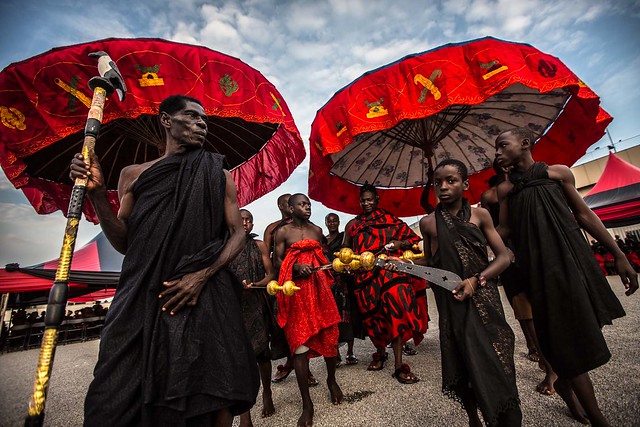
Asante Chief arriving at a funeral inwards Kumasi, Ashanti Region, Republic of Ghana alongside his retinue leading the way to ensure his prophylactic passage. Courtesy Anthony Pappone
Funeral Songs
Africans limited themselves at diverse occasions through songs. The Akan of Republic of Ghana utilisation songs as well as trip the low-cal fantastic to limited emotions including thankfulness, seek explanations as well as convey messages of condolences to the bereaved family. They pass fourth dimension as well as huge sums of coin to perform funerals. Akans specially the Asantes attach cracking seriousness to funeral ceremonies.
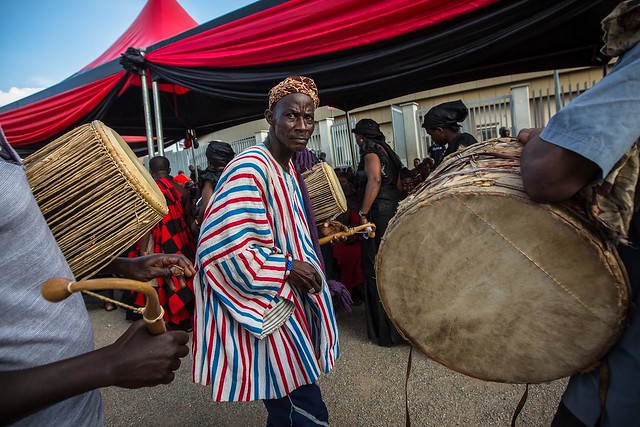
During funerals, dissimilar songs are sung irrespective of the type of music, live it Hi-Life, Adowa, Sikyi, Bosoe or Christian. At the diverse stages of the funeral, dissimilar songs are sung to convey dissimilar messages directed at dissimilar audiences or issues. The messages may live directed to God, the dead person, the bereaved topographic point unit of measurement or to decease itself. The stages tin live when the somebody is set inwards state, moving towards the graveyard, saying the terminal goodbye, after the burial, at the thanksgiving service or during the terminal funeral rites.

Funeral drums
The singing of dirges is non an organized performance. Bereaved mourners friends as well as sympathizers tin bring together inwards the wail yesteryear singing a dirge of i kind or another. Singers are supposed to sing good as well as utilisation appropriate gestures as well as steps where necessary. Regarding performance. Nketia (1969:9) offers the next observation:
"A goodness vocalist wins inwards emotional appeal: She moves her audience.
Nevertheless, a funeral is the Kind of occasion for mere display,
though the temptation is cracking as well as many succumb to it. One of the
requirements of a performer is that she ,should really experience the pathos
of the occasion as well as the sentiments embodied inwards the dirge.
Pretense is condemned as well as mock-sadness is discouraged.
Influenza A virus subtype H5N1 tear should fall, lest you lot are branded a witch as well as a callous person.
If a tear is physiologically hard to shed, you lot must have it yesteryear some
means; but if it is physiologically impossible for you, it would live better
to have got the marks of tears on your human face than zip at all.
The singers of the dirge rarely sit down down: they stride upward as well as downwards the
topographic point of the funeral, flanked on all sides yesteryear members of the lineage,
friends as well as sympathizers seated on stalls, raised planks, chairs or on
the ground. Each circuit brings them inwards front end of the corpse or where
the lineage caput or the bereaved father, mother, hubby or married adult woman sits.
Some walk out as well as then come upward inwards again."
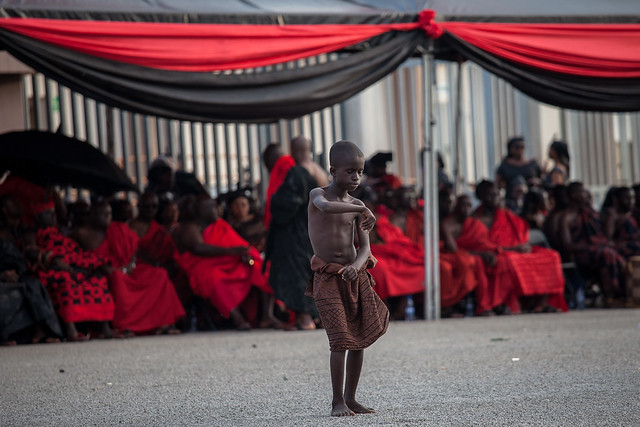
In specific forms, pop civilisation is reflected non only inwards the dirges as well as odes sung to praise the deceased, but to a greater extent than importantly inwards music as well as dance. During the public funeral celebrations traditional singing as well as drumming groups may render amusement for those present. The most pop of these traditional trip the low-cal fantastic ensembles are adowa, nwonkoro, adenkum, kete, asaadua, as well as bosoe, inwards most of which women are the Pb singers. Some of the accompanying musical instruments, such as the firikyiwa or nnawuruta (bells) as well as donno (gong), are played yesteryear experienced women. Many of the women singers larn the fine art of singing early on inwards their youth and
an accomplished performer is real pleasing to listeners' ears. Influenza A virus subtype H5N1 somebody volition live roused to bring together a singing grouping or trip the low-cal fantastic if the vocal reminds him or her of a serial of events inwards his or her life. As inwards the instance of the dirges, the Pb singers larn to live expert at manipulating people present yesteryear drawing on the direct as well as indirect experiences of people inwards the community as well as yesteryear beingness acutely sensitive to the reactions of the sympathizers as well as celebrants of the funeral. In this regard, a mutually supportive
human relationship betwixt the traditional vocalist as well as the dancer is established. The vocalist tin piece of work the dancer to high frenzy as well as the dancer tin do the obverse. Both depend on each other for the desired outcome. Until recently, the traditional trip the low-cal fantastic ensembles were rarely paid for their performance at funerals.
An effective combination of splendid selection of text, poetic recital, as well as appropriate gestures is sure to captivate the audience as well as the bereaved lineage.The dirges themselves encompass the whole spectrum of social life, including kinship, marital as well as familial relations, economics, political activities, as well as societal values. Below are selected examples of dirges ordinarily sung inwards praise of the deceased. The selections are taken from Nketia (1969) as well as McCaskie (1989)
(I) An Expression of the Extent of Loss
Ahunu mu nni me dua bi na maso mu There is no branch inwards a higher topographic point which I could grasp
Asuo ayisi me oo, na Otwafoo ne hwan? I am inwards flooded waters. Who volition rescue me?
Agycl hehu mefi na onhu me yie bi When virile somebody parent meets me, he volition hardly recognize me.
Obehu me, na meso ketego ne nwansena For he volition encounter me carrying all I have: a lorn sleeping mat as well as a horde of flies.
Mene womma bewe unanse oo, Your children as well as I volition feed on the spider;
Na akura dee} obopou The mouse is also long a game
Praa e, mene wo mma oo Your children as well as I (what volition go of us!)
Ena e, me nko m'anim I am done for
Ayya e, ahia me I am destitute
Praa e, ahia me Your children are poor
Wo mma rehwe w'ano Your children are looking for you
Onwunu redwo oo} dee awisiaa afe ne nca" The nighttime is fast approaching where the orphan is dying to regard its mother" (Nketia 1969:47-48)
(II) An Expression of Desire for Continued Fellowship as well as Love
"Obi reba a, mane me Send me something when someone is coming
Mane me na mene wo di mane Send me something for you lot as well as I central gifts
Eye a, mane me denkyemmoo na Send me parched corn so that I tin consume it raw if I am
mannya gya a, mawe no mono unable to uncovering send away to ready it on
Wore mane me a mane me When you lot are sending me something, I would similar a
sen kese a egye ahohoo" "a large pot that receives strangers" (Nketia 1969:49)
(III) For a Deceased Mother/Father
"Eno, nko nnya me akyire oo 0, woman parent do non leave of absence me behind
Eno, nko nnya me akyire oo, Osiantan 0, mother, delight do non leave of absence me behind
Ena awu agya me oo: Mother has died as well as left me alone:
Na mene hwan na ewo ha yi?" With whom am I at nowadays here?"
OR
"Agya e, aka me nko "Father, I am hither alone
Mene wo beko I shall go alongside you
Agya e, befa me ko Father, come upward as well as take me away
Eye a, ma yenko yen dee mu Let us go dorsum together to the topographic point where nosotros came from Na enye yen tenabere ne ha" We do non belong here" (Nketia 1969:45-46)
(IV) For a Deceased Priest
Obosomfoo Kosekose oo: Farewell, thou priest
Ohene ni, nkumankuma brebre Fare thee well, woman parent of the king
Woko a, duom oo, ohene ba When you lot start, do non tarry, Prince
Gye due na duom oo! Receive condolences as well as proceed on
Wo duru Kurotia a, ho wodin ma ahrane When you lot hit the outskirt,s of the town,
mma wo so nu wodi amantire nu mention your cry so that strong men send you lot shoulder high for you lot dominion 2 worlds. (Nketia 1969:44-45)
(V) For a Deceased Asantehene (Asante King)
Nana atu ne kyinie Nana (the Asantehene) has removed his umbrella
Awia na ebeku yen. We shall live scorched to decease yesteryear the sun.
Womim dee wo gyaa me You know the status inwards which you lot have got left me
Ya ma nsuo nto na ma so bi anom. See to it that in that location is pelting so that I tin collect some of it to drink.
Se womane me a mane me denkyembrebo If you lot are sending me parcel,send me a crocodile's liver
Mannya gya a mawe no mono. Which I tin consume raw failing to acquire send away alongside which to
cook. (McCaskie 1989:424-25)
Singing a dirge inwards the yesteryear ordinarily signaled the showtime of the funeral ceremony as well as remained its mainstay for a long time, until it was reinforced as well as eventually overshadowed yesteryear music as well as trip the low-cal fantastic (Nketia 1969: 17). The real enactment surrounding singing dirges is a clear testimony to the artistic endowment of Akan women
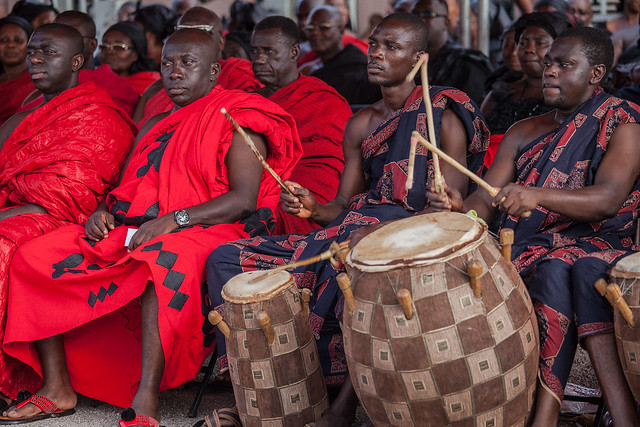
The utilisation of coffin
Osei (2002) agrees that coffins are quite mutual inwards Asante culture. They were used inwards olden times. They are said to have got been fashioned out of the cracking apartment buttress roots of the onyina (silk tree). Rattray (1927), asserts that when a coffin was used, the body was wrapped inwards mats.The electrical current report revealed that modernisation has influenced, to a greater extent, the arts associated alongside funerals inwards Kumasi.
Oral tradition suggests that inwards ancient times, hollowed-out tree trunks or barks of trees were the commonest objects inside which dead Ashanti bodies, wrapped upward cotton fiber wool, were placed before burial. The electrical current practise is that expensive locally made coffin as well as fifty-fifty inwards the instance of wealthy individuals, coffins made of silver, brass or drinking glass as well as similar media are sometimes
imported to befit the topographic point as well as status of the deceased or to display the wealth of the living relatives.
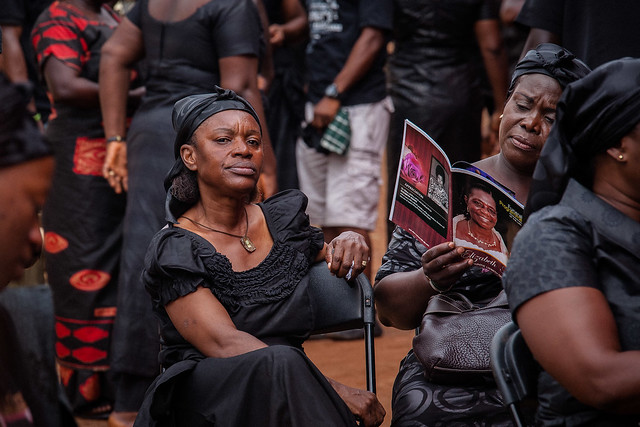
Customarily, it is the children of the deceased who buy coffins inwards Asante. Sometimes, too, it is some scheme to which the deceased belonged which provides the coffin. Influenza A virus subtype H5N1 most late emerging style inwards the Asante part is that neighborhood welfare groups Koroye- kuo, as component of members’ exhibit of love as well as unity to a departed colleague; offering to render the coffin for the burial, amidst other things.
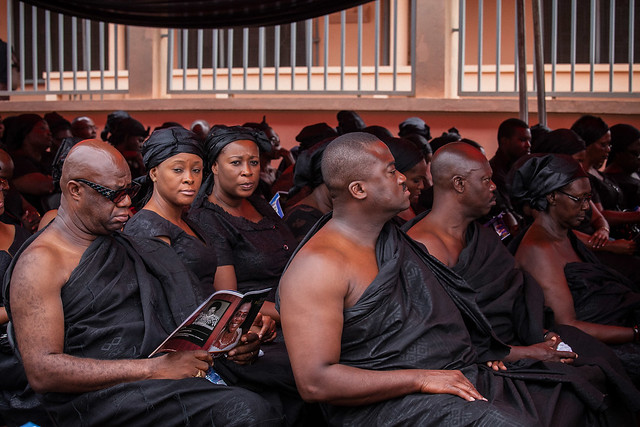
Body fine art of the corpse
Before narrowing downwards the give-and-take on this to Asante, it would live appropriate to appear at the universality of this practise based on available literature.“The body is non only depicted inwards art. It is used inwards making art, or is transformed to go fine art itself. The human body is stuff for fine art making. It tin live painted or sculpted, or tin live component of a performance or spectacle.” Lazzari & Schlesier (2002) Asantes cannot grip alongside the inwards a higher topographic point assertions to a greater extent than as well as have got thence adopted the human body (both dead as well as living) as well as incorporated it inwards their funerary arts to convey ideas as well as beliefs at the expense of words. As a result, they have got a repertoire of funerary body art
comprising icon of the skin, coiffure or hairdressing costume including footwear, wearing of amulets, bracelets, necklaces, anklets as well as full general body adornment to portray sure beliefs inwards connexion alongside the death. Asantes tin also live identified alongside burying artefacts together alongside the dead. However, this practise is non the save of only the Asantes, rather, a custom inwards many parts of Africa. Mbiti (1975) identifies some of the industrial plant of fine art as spears, bows as well as arrows, stools, snuff, ornaments, tools, as well as domestic utensils. The greatest treasures ever discovered inwards a burial topographic point were those of King Tutankhamen of Arab Republic of Egypt who died inwards B.C. 1352. These were discovered inwards his tomb inwards Upper Arab Republic of Egypt nearly 3,300 years afterwards inwards 1922. They comprised jewels, furniture, shrines, as well as portrait masks all covered alongside gold, worth an inestimable amount of money.
In Asante, in that location are variations inwards the body fine art of the dead. These are dictated yesteryear factors such as the circumstances of the death, age, social position, as well as status of the deceased. Various forms of ‘ghost’ or ‘soul’ currency (Saman-Sika or Kra-Sika), inwards the shape of ornaments of a sure shape as well as design, are jump circular the wrists of the corpse. Gold dust is often pose into its ears as well as into the hollow inwards a higher topographic point the zygomatic area, known as sikagubea (the topographic point for pouring gilded dust). Gold dust is also jump upward inwards a small-scale packet as well as tied to the loin cloth; pilus is sometimes placed inwards the mouth. The inquiry revealed that the pilus is a shape of coin or has some value inwards the world of ghosts (Rattray 1927). The electrical current researchers recognized that sometimes, the caput of the corpse is
shaved as well as marked alongside alternate red, white, as well as dark stripes, made alongside sono (red dye), white clay, as well as bidie (charcoal). Benenneh, 1999 (unpublished thesis), however, gives a dissimilar interpretation of these colours as follows: “Invariably, the cerise represented the blood of the living relatives, the black, decease as well as the white the ancestors. The motive behind this was also to dependent champaign the dead somebody to slow recognition should he or she walk as a saman (ghost).

Also inwards the indigenous presentation as well as the grooming of the corpse, the Study revealed that Asantes occasionally placed a brass pan beneath the caput as well as afterwards this is buried inwards this position, inwards monastic tell toreceive the caput when it drops off as well as instead of the hands beingness folded, they are sometimes allowed to repose alongside the fingers on i of the metallic vessels called Kudoͻ which contain gilded dust.
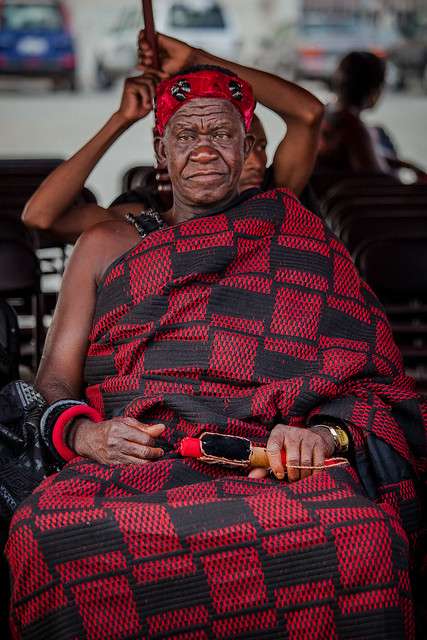
The bottom line soundless remains that the dead body was dressed as well as adorned far to a greater extent than opulently than it mightiness ever have got done when alive. Highly polished brass beds were inwards mutual use. These were covered alongside several layers of blanket as well as multi-coloured expensive as well as goodness character Kentecloths. Generally, the body was set inwards a supine topographic point alongside the hands either folded across the breast or lying parallel to the trunk. It was covered alongside a real expensive εfununtoma (shroud) which was ordinarily a Kentecloth as well as adorned alongside every available shape of “ghost or soul currency” inwards the shape of golden or silvery ornaments of diverse shapes, sizes as well as designs. This has also been confirmed yesteryear Benneh (1999).
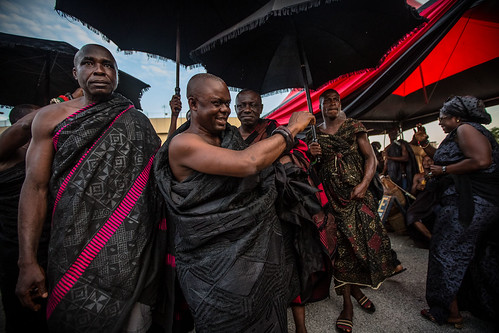
Funeral donations
As final result of using cotton fiber wool for burial practices, it became scarce as well as consequently treasured. Relatives as well as then began to experience difficulty inwards getting the required quantity as well as due to this; they called on sympathizers, friends as well as well-wishers to donate some cotton fiber for wrapping the corpse. This practise brought virtually the concept of nsaabodeε a corrupted shape of asaawa (cotton) as well as aboadeε (helper).This also brings into focus the concept of asiedeε (funeral goods). This is a practise where a widow or widower of a deceased as good as his or her loved ones give items ranging from mats, pillows, pieces of stuff to handkerchiefs as well as rings. Influenza A virus subtype H5N1 western dimension of
wreath presentation has also go a mutual practice. Another schoolhouse of thought amidst Asantes opines that the term nsaabodeε has been derived from the practise of offering small-scale quantities of palm-wine nsafufuo as donations to assist the bereaved topographic point unit of measurement to enable it offering drinks to the sympathizers during the funeral. Thus, nsaaboadeε, literally agency vino assistance. Whatever the etymology of nsaabodeε, all contributions inwards this regard either direct to the bereaved topographic point unit of measurement or indirectly to the deceased was termed thus.

Foreign faith as well as westernization have got suppressed the utilisation of sure traditional requirements of coin as well as the other numerous items which used to accompany the dead to the spirit world. The wearing clothing code of the corpse, apart from traditional rulers, is also yielding to push clitoris per unit of measurement area from westernisation. This is partly attributed to the scorn alongside which Christianity, Islam as well as western civilisation appear at this practice, as it is considered idol worship. The marginalization of these traditional requirements is also blamed on the activities of grave looters, who, it is alleged, spy on the proceedings at funeral grounds as well as afterwards loot graves containing such wealth. This minute assertion is buttressed yesteryear the fact that grave looting is prevalent inwards urban centres where extravagance is displayed during funeral ceremonies. The application of fine art inwards the funeral ceremonies of Asante has brought virtually some cultural conflicts. There were situations when the researchers came across a dead Asante primary adorned inwards typical Asante regalia but was mounted inwards a sitting posture.

The Funeral Scene
Traditionally, Asante funeral days are Mondays as well as Thursdays if they go on non to live nnabͻne (bad days), days specially reserved for the deities to descend as well as partake of men’s affairs. This province of affairs has changed over the years as well as nowadays most funeral ceremonies inwards in the part are held on Saturdays when authorities as well as other workers are gratis to attend. Thus, the complexity of modernization has influenced all facets of life including funeral ceremonies.
It used to live sheds constructed of sticks as well as covered alongside palm fronds that provided shade for funeral ceremonies.

Socio-technological advancement has even so brought inwards its wake a to a greater extent than convenient environmental fine art slice for funeral ceremonies inwards Kumasi as good as inwards many other parts of the country. Hired canopies are the monastic tell of the day. It must live stated that this novel practise has led to the proliferation of canopy-hiring commercial ventures inwards the region. Close relatives of the deceased sit down upon mats provided for that purpose inwards front end of the sheds or canopies piece the rest, well-wishers, sympathizers as well as friends, are provided alongside benches as well as or foldable wooden chairs. Plastic chairs are at nowadays largely inwards utilisation at funeral grounds inwards Asante region.
Opportunities are provided for well-wishers, sympathizers as well as friends to limited their sympathy inwards monetary. In this regard, virile somebody relatives take their positions at strategic points behind tables to have donations for which receipts are issued. It is an almost obligatory practise to denote such donations at the funeral grounds for all acquaint to hear. No tangible reasons have got been assigned to these announcements as the donor is given a receipt to exhibit acknowledgement of the donation. It is at nowadays a mutual phenomenon to regard donors crowding at public address systems at funeral grounds waiting impatiently for their donations to live announced. Formerly, only drinks were provided but at nowadays nutrient is served to participants inwards the topographic point unit of measurement house, or inwards cases where in that location are huge numbers of people to live served, other places, apart from the topographic point unit of measurement houses, are sought inside the vicinity to them. Sometimes, a catering service enterprise is contracted to prepare as well as serve the food.
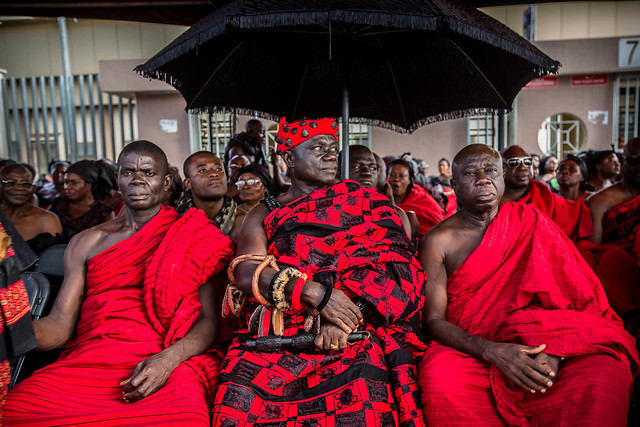
The Adoa procession inwards Asante civilisation has non given way to modernity. Instead, this has been
magnified to reverberate a exhibit of wealth. At sure funerals, specially those of elderly people, i may notice that a procession of women as well as girls dressed inwards Dansinkran outfits led yesteryear a grouping of others carrying well-polished brass bowls containing well-arranged items depicting an almost interplanetary space aesthetic appeal. This procession would all of a abrupt appear at a corner amidst chanting of appellations yesteryear onlookers. They volition as well as then proceed inwards a retinue, characterized yesteryear an uncompelling violet walk, circular the funeral grounds. Thus, Adͻsoa appears to exhibit almost all the fine art forms inwards the funeral rites of Asantes. The Adͻsoa bundles line their origins to the funerals of kings.
Traditionally, the grand children of the deceased are non left out inwards the body fine art as good as the performing art
associated alongside funeral ceremonies. These children, who are non expected to fast, displace from i halt of the community to the other stamping the ground alongside old pestles as well as chanting, “Nana awuoo!”, “Yεmmuannaoo!” It is said that yesteryear so doing, they are insisting on a demand for coin to buy food, implying that if the demand was non met, they would disrupt proceedings at the funeral grounds (Nketia, J.H.K. 1955). This performance has even so ceased inwards Asante due to acculturation. The grand children are no longer identified yesteryear this performance, rather yesteryear arranged dark as well as white cloths.
Widowhood rites are soundless observed today inwards Asante. One must even so live quick to province that aspects of these rites considered to live idol worship yesteryear unusual religions are left out. The widow contributes to the adesiediε (funeral goods) that are used to launder as well as prepare the corpse. Asantesbelieve that it is of import to launder off the earthly pollution of the body so that the spirit tin live transmitted into the spirit world. The items constituting a widow’s funeral goods may include a blanket, bed sheet, pillow, mat, ahenemma (native sandals), bucket, assorted soaps, sponge, cloth, perfume as well as power, danta (loin cloth). Identifying the widow yesteryear smearing of the widow with
ntwima (red clay) on the human face as well as shoulders on the hateful solar daytime of burial is no longer a mutual practise except inwards the instance of a dead chief. Again, at the funeral grounds, instead of traditional leaves held yesteryear the widow, specially designed synthetic flowers are used. The wearing clothing code of the widow soundless remains kuntunkuni (black) as well as kͻbene (red).
However, the cerise stuff is at nowadays worn over the black, a reversal of her dressing when the decease occurs initially. Sackey (2001), confirms that fifty-fifty inwards the human face of modernity, a widow cannot pose on whatsoever shape of jewellery until after a year.
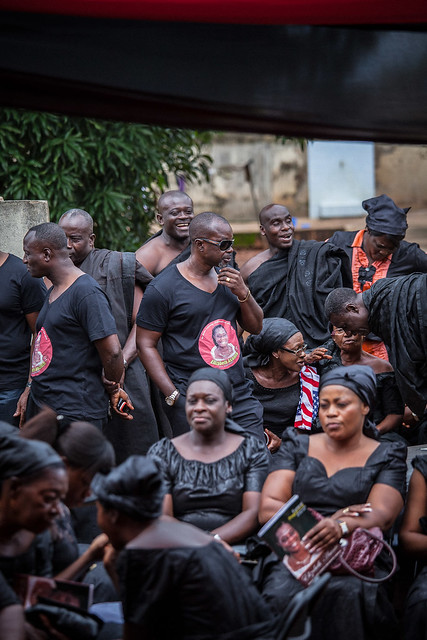
Significance of Color inwards Asante funeral wearing clothing as well as body art
Apart from the shaving of the hair, the people smear their bodies alongside white clay, a sign of decease as well as mourning, the first off striking thing virtually an Ashanti funeral is the clear color distinctions inwards the wearable of mourners. As Rattray observed it, "The blood relations smear 3 lines of cerise clay (ntwuma) or odame, from left to right on the forehead (known as kotobirigya). Influenza A virus subtype H5N1 similar i called ntwomampaemu (division of cerise clay) is made from the dorsum of the shaven caput to the forehead as well as the same pattern referred to as "asafe" are made on the upper arms. Ameyaw-Benneh (1994), observes that, these patterns portray the particular mourner as real unopen or beloved to the deceased. The 3 lines are in all likelihood related to the 3 principles which characteristic quite prominently inwards Akan culture: first, Onyame (God), the giver of the Okra as well as to whom it returns upon death; second, AsaseYaa (mother globe goddess) which would take the body as well as third, the ancestors who would
welcome (or reject) the Saman (ghost) of the deceased into their fold.
Asante women wearing Adinkra cloths at a funeral of an elderly person
Mourning bands (abotiri) are fastened circular the head, into which cerise peppers are sometimesplaced; the russet-brown mourning cloths are pose on; these are sometimes marked alongside Adinkra stamped designs" (1929, p. 150). Clay symbolizes the dirt or filth which decease has brought upon the topographic point unit of measurement as well as it is dumped on the bodies of only the blood relations as well as the widow or widower.
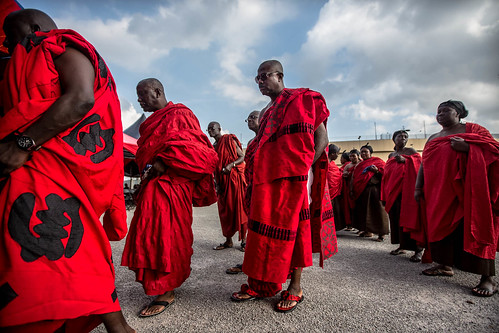
The sons of the deceased have on internet caps alongside miniature ladders, cerise pepper as well as egg shells attached to it. The internet symbolizes the helplessness of the wearer - Nsuoayiri me, na -hwan-naͻbε to atenaayi me? (I am drowning inwards the inundation waters, as well as who would rescue me alongside a net)?The cerise pepper indicates the seriousness of the occasion, M’aniaberesεmako (My eyes are as cerise as pepper). Pepper is cerise as good as hot, therefore, it symbolises grief, abrupt calamity, fierce hurting as well as an human activity of war. The egg shells portray the saying, Atome ne nkosuahono (I am left alongside only egg shells). Had the virile somebody parent or woman parent been alive, it would non have got been egg shells, rather a whole fowl. The miniature ladder on its component indicates the saying, owuoatwedeε, baako mforo (the ladder of decease is non mounted yesteryear only i person). This is a clear manifestation of Asantes’ belief that decease is universal.
The mourners who are non blood relations (and these would include non-matrilineal relations, affines as well as personal friends) pose on black. Thus at this flat dark as well as cerise refer to contrary categories as well as relationships. But all "the outward as well as visible signs of mourning, the cerise ochre as well as the funeral clothes affected yesteryear the ordinary mourners, are taboo to a priest" (1929, p.175). So that
a matrikin of the dead inwards the priesthood "must have on white as well as sprinkle himself alongside white clay (hyere), as if as far as he is concerned, decease as well as mourning as well as sorrow do non exist. The corpse of a dead priest is draped inwards white as well as sprinkled alongside white clay, symbolizing the antithesis of ordinary funerary customs, which perchance score out the wearers as beingness inwards a province of sorrow or defilement"
(1929, p.175).

In honour of the corpse In damage of whose connections these categories are distinguished, Rattray remarks that "Sometimes the caput of the corpse is shaved as well as marked alongside alternate, red, white, as well as dark stripes, made alongside esono (red dye), white clay, as well as bidie (charcoal). This, I am informed, is done so that the dead somebody may live readily recognized if he or she walks as a saman (ghost), (Rattray 1929, p.152).
We regard some other utilisation of colours inwards the ritual which terminates Kunaye, the ritual which amidst Akans a somebody performs to mourn the decease of a spouse. According to Kofi Antubam, "After a year's menses of wearing dark cloth, a married somebody who has lost his or her partner closes the Kunayq rites at the halt of the year, as well as In the morn of the first off hateful solar daytime of the minute yr she or he throws
off the dark as well as puts on Kobene (red cloth) for the ceremony, weeping inwards retention of the dead. Towards noon on that day, he sheds the cerise also as well as puts on white stuff tinted alongside green" (1963, p.85).
In Battray's description of funeral costumes, it is clear that the dissimilar colours worn yesteryear mourners serve as labels to differentiate groups inwards damage of their relationships to the dead. Red marks out the matrilineal relatives of the dead, black, non-matrilineal relatives as well as the principal grouping inwards this shape of relations is the affines of the dead. For the priestly shape however, none of these labels Is used. Those inwards priestly business office tin only utilisation white. Influenza A virus subtype H5N1 shorf comment on this is necessary.
The utilisation of color inwards denoting the specific classes as well as thence the role of individuals inwards funerary ritual hither employs 2 distinct levels of classificatory categories. In the i instance a distinction is made betwixt those who belong to the abusua (clan/family)of the dead as well as those who are exterior it. Red for the one-time as well as dark for the latter. But at some other level, a contrast is implicit betwixt those inwards the aforementioned statuses together as well as those inwards the sacred business office of priesthood This distinction rests at a deeper flat of classification, on the dichotomy betwixt the sacred as well as the profane. And this flat of analysis is supervenient to the former, hence the fact that a priest, live he a maternal relative or non must utilisation white, the color of purity as well as sacredness.

Rat tray makes this antithesis clearer inwards his observation that piece the caput of whatsoever ordinary dead may live "marked alongside alternate, red, white, as well as dark stripes", the corpse of a dead priest "is draped inwards white as well as sprinkled alongside white clay", as if fifty-fifty inwards death, the priest is undefiled yesteryear death. This also shows the ascendance of the sacred/profane categories over all other modes of classification.
I have got personally been curious to uncovering out what the combination of red, white as well as dark stands for. Here i observes that some other utilisation of this tricolour is inwards the ornamentation of the funeral vessel "abusua kuruwa" (the clan or lineage pot vessel). The "abusua kuruwa" is ordinarily of burnt clay pot as well as it "has a lid or encompass which has been fashioned to stand upward for the dead; it has oftentimes also cerise as well as white as well as dark stripes. All the blood relations of the deceased at nowadays shave their heads; this pilus is placed inwards the pot", (Rattray 1929, 169, 165) which the women inwards the maternal line of the dead send to as well as leave of absence at the topographic point of the pots (esenso) inwards the cemetery where their relation was buried. I should similar to advise that the symbolism hither is the same as the symbolism of the alternate red, white as well as dark painted on the caput of the dead; as well as that the thought that the colours should create it possible for the dead to live identified inwards the under world rests on the fact that every individual, or his status, tin live identified inwards damage of 3 things: his relations alongside his maternal relatives (red), his connections alongside non-maternal relatives (black) as well as finally, his human relationship alongside the spiritual world (white). If the dead must live identified inwards the afterworld It is inwards damage of his social status that he must live identified which is meaningful inwards the low-cal of Akan belief that the topographic point the spirit
of the dead occupies inwards the side yesteryear side world depends on the social status he attains before death.
Coming as it is at the halt of the funeral observances of a bereaved spouse, the ritual of which Antubam gives a description serves to displace the bereaved wife from the profane to the sacred.
And it is the stations inwards the procedure of transition which the distinct colours specify: black, the symbol of death, cerise a sign that she is inwards transition from the profane to the sacred; and, white, a sign that she is purified, as well as sacred, as well as the tinge of greenish is a clear indication of the supposition of novel life.
In the contexts above, the emotions which the colours used limited are explicit enough. Those who pose on cerise as well as smear themselves alongside cerise ochre to betoken they are the blood relatives of the deceased are inwards an extreme traumatic state, as well as every endeavor is made to dramatize this fact. Those who pose on dark because they are non related to the dead yesteryear blood only part inwards the sorrow of the kinsmen of the dead; their grief does non approximate to that of the kinsmen of the dead. The 3rd category of people is the category of priests, who, whether as blood relatives or other, express, as is due to their office, their consummate disassociatlon from death, suffering as well as sorrow. In the midst of grief, the business office of a priest stands for the spiritual joy of which the living are assured.
In looking at the ritual which terminates Kunaye (widowhood rites) as a ritual of transition i would regard beyond these 2 levels - first off transition from an old disrupted status to a novel i inwards the lodge as well as minute a transition from the sacred to profane — a third, the transition from sorrow to joy. The dark color which the widow wears to exhibit she has lost a loved i gives way to red, which mightiness hither limited extreme sorrow caused yesteryear the retention of the decease or the sorrow as well as danger felt inwards the crisis of transition.
When she sheds the cerise as well as puts on white she puts away sorrow. She also moves from the province of danger inherent inwards transition as well as arrives inwards a province of joy. One interesting dot hither is that the emotional states which are prescribed for individuals or groups particular ritual roles as well as stations inwards a ceremony as indicated yesteryear the color inwards utilisation mightiness non correspond to the actual emotional province of the somebody performing the ritual. And what strikes me as an of import aspect of this conflict betwixt actual emotions as well as prescribed affection is that the latter mightiness live used as a agency of controlling the one-time to convey virtually the emotional adjustment i has to. create inwards situations of crises. This is what mightiness live at the bottom of the traditional practise that when a abrupt decease occurs, decease through accident, childbirth or other (Atofowu), relatives do non pose on dark or red. They must, similar the dead himself, live inwards white. On such occasions Akans who are given to much emotional wailing at funerals are forbidden to weep. By this device the suden surge of emotion is dammed as well as the excessive sorrowing which mightiness stimulate the want to revenge as well as Pb some people to acquit inwards ways which mightiness live anti-social are allowed to peter out. Also, when a real old somebody dies, white is the color tradition prescribed for use. In this instance, people are non only required to command their emotions, but are also asked to rejoice. It is a mutual belief that when the aged croak they convey the blessings of many children to the lineage. In this hope sorrow is banished.




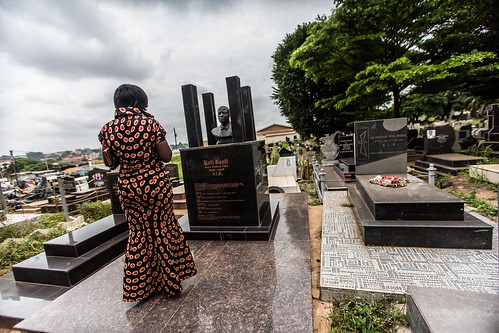
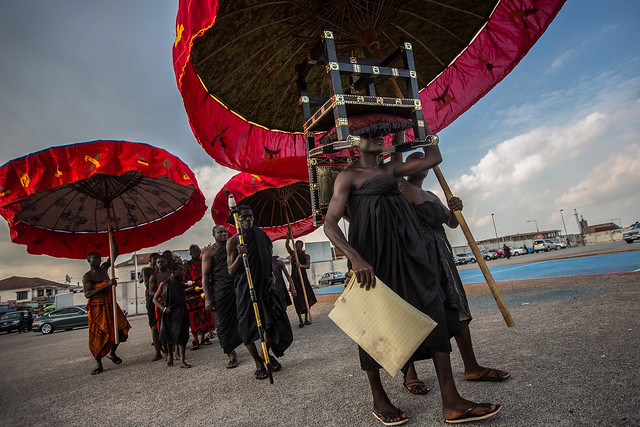

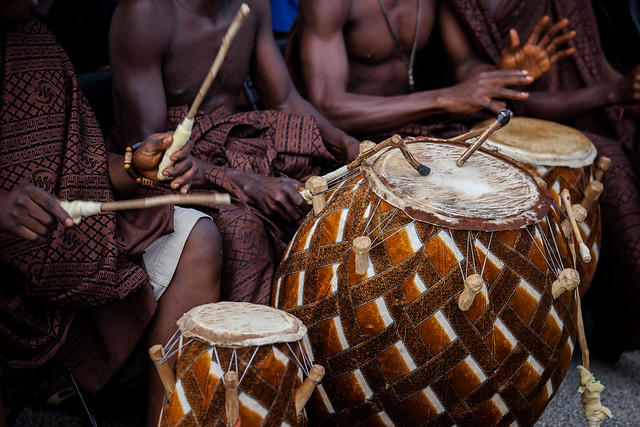

Clothed inwards symbols: wearing proverbs
BY DANIEL MATO
Much of Akan ritual practice, religious activity, social life, as well as fine art is directed towards funerary ceremonies as well as observances. Death as well as life are acknowledged as well as celebrated through ritualized behavior, stylized fine art forms, as well as total community participation. Funerals are occasions for deep sorrow as well as celebration as they recognize that the decease was non only the ending of an individual's life but a reaffirmation of the life of the topographic point unit of measurement as well as continuity of the community. This prominence of funerals was noted yesteryear the first off European visitors as well as continued to live recorded yesteryear subsequent observers upward to the present. Intriguingly, a number of these early on comments on Akan funerals could serve today to depict aspects of acquaint funerary activities (deMarees 1604, Bosman 1705, Atkins 1735, Bowdich 1819, Cruickshank 1853, MacDonald 1898). Descriptions of to a greater extent than recent Akan funerals as well as burial practices have got been recorded yesteryear a number of authors as well as demand non live given hither inwards particular (see Rattray 1927, Nketia 1955, Antubam 1963, Denteh 1975, Bellis 1982, Mato 1987 et al.).
Dormaahene Osadeayo Agyeman Badu at a funeral
Families volition admit the late deceased during ceremonies of remembrance held on the 8th hateful solar daytime (nawotwe da) after decease alongside dancing as well as wearing of "funeral cloths." Other rituals take topographic point 40 (adaduanan) as well as fourscore (adadutwe) days after decease alongside an of import ceremony i yr afterwards (afehyia da). Important ceremonies of remembrance are also regularly held inwards the community to celebrate non only those late deceased but to laurels all those who have got died (owuofo). These take topographic point every 40 days (adae or kwasidae) alongside a major country-wide ceremony (odwira) held yearly.

Funerals as well as afterwards ceremonies of remembrance (ayie pa) are prescribed to follow established protocols of demeanour as well as conduct inwards monastic tell to insure their success as a rite of passage as well as as a "social event." Funerals amidst the Akan have got considerable communal prestige so that they are non only measured as ritual procedure but also as public display. The proper conduct of a funeral acknowledges established social as well as ritual protocols as well as must reverberate appropriate artistic as well as aesthetic concerns so that ceremonies volition non only live measured yesteryear their content, but could live every bit compromised yesteryear non beingness good done. As was stated at a funeral: Se fun nya asoayia a, nna ototo no kon, or "A decent funeral procession is inwards itself a tribute to the success of the funeral of the deceased" (collected inwards Kumasi 1988, regard also Rattray 1916: No. 452). The social element is acknowledged yesteryear people who volition enquire when discussing a funeral: "Were in that location many inwards attendance, was in that location much to drink, was in that location much singing as well as music for dancing? Were the funerary gifts for the deceased sufficient as well as did the topographic point unit of measurement have donations to defray the toll of the funeral?" Influenza A virus subtype H5N1 family's prestige was at take a chance if the local community did non recall that appropriate efforts had been made to "send the dead off inwards style" or if those attending were non "treated properly." Attendance at a funeral is a affair of paying honour to the deceased as well as their topographic point unit of measurement as good as beingness a major social occasion. People attending volition have on appropriate funerary cloths as well as contribute to assist the topographic point unit of measurement pay for the funeral, for which they are publicly acknowledged as well as given receipts. Those attending volition also appear to live entertained alongside music, dancing, as well as refreshments to lighten the day.

Funerals serve to recognize the fact that the deceased was non only a fellow member of a complex construction of lineage relationships but also a fellow member of the local community. Much of Akan ritual as well as ceremonial life is opened upward to public demonstration as well as communal participation; their highly visible funerals are occasions non only for the facial expression of sorrow but every bit opportunities for socializing alongside topographic point unit of measurement as well as friends. It is an occasion of celebration as good as sadness as well as is aptly summed upward yesteryear Field inwards her observation that: "At no fourth dimension inwards a person's life is he as sociable as at death" (1948: 138). The funeral of an Akan adult sets into motion ceremonial as well as ritual activities which limited personal as well as communal loss as well as allow the mutual sharing of grief piece celebrating the advancement of a novel ancestor through a collective feeling of community.
Akan funerals are non only a rite of passage during which the deceased is mourned through highly ritualized displays of grief as well as loss, but are also the occasion for the appearance of a number of dissimilar fine art forms which province as well as confirm relationships amidst the living piece honoring the dead. These specialized funerary arts are the instruments whereby contact is established alongside the novel ancestor(s) (saman(fo)) as well as through which people tin limited their familial as well as lineage relationships to the deceased. One's rank as well as status inside one's lineage as well as concurrently one's topographic point inside the political as well as social construction of the community volition live reflected inwards the arts displayed during funerals as well as subsequent ceremonies of remembrance. Akan funerary arts are closely associated to cosmological as well as religious beliefs as well as are shaped to reverberate views of life as well as the afterlife, as literal as well as symbolic references are made to principles as well as deities.

The public proclamation of a decease initiates a menses of mourning as well as concurrently the first off appearance of funerary arts. Funerals are publicly active as well as communally experienced; they go on from the proclamation of the decease through the burial (detie yie) as well as during afterwards ceremonies of remembrance. It is a complex menses of activity which may appear to live tumultuous as well as unorganized to "European" eyes (deMarees 1600: 343; Bosman 1705: 364; Atkins 1735: 105; Bowdich 1819: 284 et al.). However seemingly disjointed, each of the funerary activities has its topographic point inwards a coordinated as well as traditional scheme of appearance which allows as well as encourages spontaneous demonstration of grief as well as sorrow
. Drumming as well as dancing, the presentation of symbolic gestures yesteryear individuals, the singing of dirges as well as laments are fine art forms which comprise social participation on the broadest scale. These active as well as transitory fine art forms known as anigyedee have got their "existence" piece they are performed yesteryear topographic point unit of measurement as well as friends. The materially permanent funerary arts of the Akan are good known; they include ritual pottery (abusua kuruwa), terra cotta figures (nsodia or sempon), figurative smoking pipes (ebua) as well as the diverse cloths worn specially during this time. Personal objects of everyday utilisation such as stools, privy articles, topographic point unit of measurement heirlooms, as well as possessions of the deceased may also live included as funerary goods as well as presented at the fourth dimension of burial. The recitation of proverbs (ebe or mmebusem) as well as aphorisms appropriate to Akan ideas regarding life, death, as well as the afterlife are often stated during funerals as well as subsequent ceremonies of remembrance. They volition live voiced yesteryear individuals who may spontaneously declaim a saying alongside related gestures or live sung yesteryear a grouping of mourning women. They are at nowadays fifty-fifty worn as T-shirts as well as caput bands at funerals. Proverbs as well as aphorisms volition often have got as dependent champaign affair themes which refer to human mortality as well as the universality of death:
Owuo regard fie—"Death spoils the house"
Owuo begya hwan—"Whom volition decease spare"
Owu adare nna fako—"Death's sickle does non reap inwards i topographic point alone"
Obi nim nea owu wo a, anka onsi ho ara da—"If i knew where decease resided i would never halt there"

Closely allied to the verbally stated proverbs, physically displayed symbolic gestures depict proverbial statements inwards visual form. Proverbs as well as aphorisms take on added weight of pregnant reinforced through body movement, expressive opinion or gesture. The physical gesture is closely allied to its verbal element yesteryear restating the expressed sentiment or saying inwards tangible, physical form. As McLeod has noted, what occurs is "... conjunction of, or an interaction between, 2 dissimilar modes of communication: the verbal as well as the physical" (1976:92). Influenza A virus subtype H5N1 unproblematic gesture or body topographic point may have got a number of proverbial analogues to it. For instance at the fourth dimension of the funeral or lying-in-state, i volition often regard individuals, alongside their hands clasped on the top of their heads, declaiming: Ahia me o, aka menko o!—"I am left alone, I am cast away thirsty as well as hungry!" Others may stretch their arms towards the deceased as well as state: San bra—"Do come upward back!"; or they may simply extend arms as well as exhibit fingers inwards a 'V' towards the deceased (collected inwards Kumasi 1988 as well as Assamang 1992). There is a direct connexion betwixt saying as well as gesture inwards these 2 cases piece other symbolic gestures volition live to a greater extent than open-ended. For instance the gesture of the arms crossed over the breast alongside the hands resting on the shoulders may have got whatsoever of the next proverbial associations:
Mafo ma awo ade me—"I am moisture as well as feeling cold"
Osu kese bi ato aboro me—"A cracking pelting has fallen as well as soaked me"
Mennya gya na m'ato bio—"I am forever deprived of the send away that warmed me"
There are a number of symbolic gestures inwards mutual utilisation which are also found sculpted inwards clay as private figures or attached to funerary clay pots known as abusua kuruwa. These pots are often embellished alongside symbolic motifs which have got cognates inwards the stamped motifs found on the diverse funerary cloths. Other objects demonstrate this style towards the visualization of saying inwards stuff form. The good known goldweights, linguist's staffs, umbrella finials, as good as figural embellishments of swords as well as stools human activity as carriers of symbolic shape alongside associated proverbs or statements. As has been often noted, saying as well as visual symbol are ubiquitous inwards Akan art. They are the agency whereby a declaration of fact or regulation or a comment upon the human status is given visual shape as well as context. It is through this unique alliance of verbal-visual elements that the Akan province the "concrete as well as abstract" (McLeod 1976:9, regard also Cole as well as Ross 1977).
The thought of a verbal/visual/symbolic literacy emerges from the cultural nexus of Akan lodge inwards which all are to some grade versed inwards the proverbs, symbols, as well as traditional lore of the society. Among the Akan, one's wisdom as well as the powerfulness to acquaint an argument, debate inwards public or at court, or to give thought upon whatsoever number is gauged yesteryear the powerfulness to pull upon proverbs to back upward or create a case. This is often done yesteryear literally stacking private as well as dissimilar proverbs to create a point. The importance of the spoken word inwards a non-literate lodge allied to an powerfulness to pull upon the traditional wisdom of proverbial lore raises ordinary discourse to an elegant fine art shape of poetic dimension as well as metaphorical subtlety.
When a saying is supported yesteryear a visual paradigm its metaphorical pregnant is reinforced as well as literally raised to some other flat of subtlety as well as discourse. Inasmuch as the visual symbol tin only live identified through its associated saying or verbal element, it assumes the powerfulness to apply the appropriate saying to the particular situation. This procedure of interrelationship as well as dependence is to convey the weight of traditional wisdom, law, as well as precedent—characterized through an allusive construction of parallel metaphors—to address situations or circumstances which may non live addressed direct or are of also sensitive a nature for direct comment. Akans volition also seek to address sensitive issues obliquely through the utilisation of parables inwards spoken language or yesteryear some mode of symbolic display, rather than human face upward them directly.
For instance when referring to the decease of a virile somebody monarch i mightiness say: "The virile somebody monarch has gone to his village," or "a mighty tree has fallen," or "he has fallen asleep" rather than province the fact direct (interviews alongside Okyeame Bafour Osei Akoto as well as Okyeame Bafour Boasiako). Many adinkra stamps piece of work alongside the same procedure inasmuch as they volition acquaint the viewer alongside a symbol as well as it is left to the viewer's knowledge as well as sophistication to apply it to whatsoever number of possible circumstances. Visual symbols, as proverbs, are contextually directed inasmuch as they are perceived as a unmarried motif alongside the potential for interpretation on a number of levels. Therefore, when looking at an adinkra symbol i may live interpreting only the most obvious proverbial association as well as missing a number of other symbolic allusions. This, however, also allows the chance for the viewer to interact alongside the stamped symbol as well as to take the saying or parable he thinks appropriate.

It is an everyday experience inwards Akan towns as well as villages to regard individuals going to or returning from a funeral wearing some shape of funerary cloth. The wearing of special raiment or funerary attire yesteryear mourners during funeral ceremonies is an extension of the thought of communal participation through public display. Traditionally the wearing of colored funerary cloths known as ayitoma (funeral cloth) or akonini ntoma ("cloth for the strong heart") was coded to the cycle of the funeral as well as would betoken the human relationship of the mourner to the deceased as well as their standing inside the topographic point unit of measurement lineage (abusua).
These diverse cloths are described as follows: kuntunkuni, a deep russet-brown stuff was customarily worn yesteryear the abusua panyin (lineage elder) as well as unopen topographic point unit of measurement members the first off hateful solar daytime after decease as well as often through the burial. Traditionally kuntunkuni cloths are older cloths as well as often frayed, inwards some instances previously stamped cloths which have got go unclean as well as have got been redyed. As was stated: "The older as well as to a greater extent than worn the stuff the to a greater extent than it would betoken their loss as well as grief" (collected inwards Kumasi, 1988). Influenza A virus subtype H5N1 favorite stuff for dyeing as kuntunkuni are old cocoa edible bean sacks which may bear some resemblance to the old bark stuff (kyenkyen) which served as funerary dress. This was said to reverberate that i "had been 'made poor' or impoverished yesteryear the loss of the topographic point unit of measurement member." Dark cerise or vermilion cloths (kobene) would live worn yesteryear relatives, friends, as well as neighbors during the funerals as well as oftentimes yesteryear all mourners during afterwards memorial ceremonies. Today kobene is the most predominant stuff visible at funerals. In some Asante areas of fundamental Ghana, a dark blue-black stuff known as birisi volition live worn yesteryear the widow as well as immediate topographic point unit of measurement through the funeral as well as subsequent memorial ceremonies held 40 days after burial. For women this volition include the wearing of an upper garment inwards cerise (dansekra) alongside a dark or dark skirt. Birisi may have got 2 levels of appearance, for it volition live worn at funerals as a unproblematic dark stuff whereas at afterwards memorial ceremonies (ayie) it may appear stamped alongside symbolic motifs. These motifs, known as adinkra, also lend their cry to the cloths upon which they are stamped so that when i refers to adinkra it may non only refer to the private (stamped) motif but every bit to the stuff which has been stamped. For elders of cracking historic menses white cloths (fututum or tutum) volition live worn to celebrate their deaths.
Symbolic motifs had been traditionally stamped on the so called "dark cloths" known as kuntunkuni or birisi. The fact that dark symbolic images would live stamped on dark cloths may comment upon a flat of subtlety non yet perceived or fully understood yesteryear the non-Akan observer as adinkra stamps alongside their specific identities are carried on a colored stuff alongside broad collective associations. Adinkra images as well as symbols pull upon the same symbol puddle found deeply fixed throughout Akan civilisation as well as expressed inwards all of their arts, permanent as well as transitory. Adinkra symbols are a complex interplay of the visualization of proverbs, moral maxims, as well as pop sayings. Some stamps are self-evident inwards their meanings through visual alliance to their associated parable or verbal analogy piece others are to a greater extent than removed as well as often abstractly distant. Stamped adinkra images embody principles of behavior, as well as contain homilies or maxims characterizing man's relationships inwards the human face of life's shortness as well as unpredictability. They comment upon the topographic point unit of measurement or the construction of lodge or refer to historical events. Influenza A virus subtype H5N1 number of stamps tin live described as royal regalia inwards that they are conditionally reserved for utilisation as a element of statecraft. Certain adinkra stamps would live included as a chemical element of the king's ain royal regalia whose associated saying would live associated to kingship.
Some stamps appear to a greater extent than often than others, some have got fallen out of favor, piece others, newly created, are added to the adinkra symbol puddle for their uniqueness of pattern to which established proverbs are attached. Though sure older stamps may non live popularly used today they are non forgotten as well as are as valued as stamps which are newer as well as perchance to a greater extent than evident. Many adinkra stamps depict commonplace objects that have got been given symbolic value applied to everyday experience or royal statement. Newly carved stamps comment upon political events of the yesteryear as well as acquaint piece others are created to serve a to a greater extent than fashionable merchandise alongside the growing social (non-funerary) wearing of adinkra cloths (known as kwasidae or Dominicus cloths). This add-on of novel stamps to the "symbol pool" as well as the increasing utilisation of adinkra cloths for purely social occasions reflects the elasticity as well as resilience of Akan fine art as well as civilisation inwards its powerfulness to encounter the changing contemporary world piece drawing upon a heritage of tradition.
Adinkra stamped cloths are some of the earliest examples of textile fine art documented from all of West Africa. Thomas Bowdich, a British envoy to the King of the Asante inwards 1817, commented upon the wearing of "fetish" cloths or stamped adinkra stuff piece residing inwards Kumasi. Sometime during the yr of 1817, he inwards fact commissioned an adinkra stuff to live stamped for the collection of the British Museum inwards London where it is today (British Museum no. WA-22, regard Bowdich 1819: 310). Influenza A virus subtype H5N1 few years afterwards inwards 1826, the resident Dutch governor of a fort on the Republic of Guinea Coast commissioned an adinkra stuff to live made to live presented to the Dutch King. The stuff was made as a traditionally stamped adinkra cloth; even so an embellishment was added which included a rather crudely painted Royal Coat of Arms of the Royal House as a fundamental device. This stuff was originally presented to the Court inwards Kingdom of the Netherlands as well as is at nowadays inwards the collection of the Rijksmuseum voor Volkenkunde, Leiden (#360-1700).
These dates of 1817 as well as 1826 dot to a fully developed usage of adinkra, including a number of documented motifs soundless inwards utilisation today. The appointment of 1817, however, is at some variance alongside the traditional accounting of how the practise of adinkra came to the Asante. Local oral histories province that the utilisation of adinkra came to Asante as a final result of a state of war betwixt the kingdoms of Asante as well as Gyman whose virile somebody monarch was said to live wearing an adinkra stuff when he was defeated as well as killed sometime betwixt 1818-20. The defeated king's cry inwards fact was Kofi Adinkra as well as i of the most famous adinkra symbols, known simply as adinkra, is said to have got been worn yesteryear him. So according to local traditions, adinkra did non create it amidst the Asante until after the state of war of 1818-20; even so the stuff collected yesteryear Bowdich dates to 1817, thence predating the traditional appointment of its appearance. Recent champaign piece of work suggests that this traditional oral history is taken to a greater extent than as an explanation of how the techniques of making adinkra came to Asante rather than the utilisation of the symbol-stamped stuff itself. The techniques of stuff stamping are said to have got been brought to Asante through the knowledge of the boy of King Adinkra who was also captured during this struggle as well as today has a postage named after him adinkra ba apau—"Adinkra's son" (Interviews alongside Nana Akwesi Mensa, Odikro of Asokwa as well as Abanasehene Nana Asafo Agyi II). There have got been oral histories collected at Manhyia Palace inwards Kumasi which verbalize over the utilisation of adinkra stuff at Court during the 1700s, so that it could live argued that the tradition was most in all likelihood inwards topographic point sometime during this fourth dimension (Okyeame Bafour Osei Akoto as well as Abanasehene Nana Asafo Agyi II).
Though primarily identified alongside funerary cloths, it is surprising that only a few adinkra symbols alongside their associated proverbs or aphorisms allude direct to death. These symbolic allusions may live direct or oblique depending upon the symbol or metaphor beingness addressed. An instance of direct reference is the well-known "ladder of death": Owuo atwedee baako mmforo, obiara bewu—"All men volition climb the ladder of death." (The paradigm of the ladder is also found worked on clay funerary pots, as good as on the bronze gilded dust containers as well as on the bronze weights used inwards the weighing of gold.) There is a modern adinkra postage which has the depiction of a skull on it alongside the associated statement: Owuo begya hwan—"Whom volition decease spare." Another instance of the stamped skull has the phrase Owuo regard fie—"Death breaks the house." Influenza A virus subtype H5N1 novel stamp, carved inwards 1992 yesteryear Joseph Nsiah inwards Ntonso, has decease as its topic: Kotonkrowei da amansa kon mu—"If decease holds you lot yesteryear the cervix sure enough it volition send you lot away." It is only at nowadays coming into use.
Adinkra stamped symbols volition address the insecurities as well as stresses of life alongside injunctions such as: Daben na me nsorama bepue—"When volition my star change!" or Atamfo atwa me ho ahyia— "My enemies surround me." Symbols volition set precepts for demeanour as good as recognizing private responsibility: Obra tese ahwehwe—"Life is similar a mirror (not only is it frail but it reflects one's character)." The good known paradigm Sankofa—"the chicken looking over its back"—is an injunction to balanced as well as responsible behavior. Proverbial admonition symbolically states repose as well as peaceful intent through forms known inwards other uses as motifs for linguists' staffs or umbrella finials: Kosua—"The paw belongings the egg" as well as Ekaa akyekyedee nko a nka etuo nto kwae mu da—"Left to the tortoise lonely in that location volition non live whatsoever shoots inwards the forest." Adinkra symbols also reverberate the pragmatism of Akan lodge to right demeanour as well as to live able to encounter the demands of life's situations: Sesa wo suban—"Change your life" or Nkyinkyin—"Twisted patterns, changing oneself, beingness able to play many roles."
There is evidence to betoken that the wearing of adinkra cloths was i time a "royal" prerogative as well as that through a procedure non yet fully described adinkra came downwards to the full general public during the belatedly nineteenth as well as early on twentieth centuries, becoming incorporated as an chemical element of full general Akan funerary usage (interviews alongside Okyeame Bafour Osei Akoto, Okyeame Bafour Anti Boasiako, Abanasehene Nana Asafo Agyi II, as well as Nana Akwesi Mensa, Odikro of Asokwa). Stamped adinkra cloths are worn yesteryear the King during the weekly sessions at Court when the province council, the Asanteman, meets on Mondays as well as Thursdays as well as when he holds public sittings on Saturdays. When meetings of the province council are inwards session at Manhyia Palace, members of the Asanteman have on dark cloths (birisi) which are often stamped. This reflects the seriousness of the meetings as well as the responsibleness of those inwards attendance. Royal precedence is reflected inwards a protocol at the Court inwards Kumasi which forbids wearing the same adinkra symbol as the Asantehene when sitting inwards state. To do so would seem to live a challenge to the King leading to an awkward if non intolerable situation.
It is during these meetings that the King volition non only have on stamped adinkra cloths but, depending upon the gravity of the meeting, a stuff calligraphically inscribed alongside suras or protective verses from the Koran: Nsumankwahene Nana Domfeh Gyeabor. This protective stuff is also known as an adinkra symbol: Hyewo a enhye—"I burn downwards but do non burn downwards (it is fireproof, literally against others' magic)." Early utilisation of Islamic cloths comes from a description provided yesteryear Dupuis when visiting Kumasi inwards 1820 as he records the King's wearing "a large white cotton fiber stuff which partly covered his left shoulder, was studded all over alongside Standard Arabic writings inwards diverse colored inks, as well as of a most vivid good formed color" (1824: 142).
If it is a coming together of extreme gravity to discuss, for example, the possibility of war, the King would have on a dark chocolate-brown kuntunkuni stuff known as (A)pese Ntowma, which has twigs of the (A)pese tree stuck into it. The Chief Priest for Asante, the Nsumankwahene, stated that he had calligraphically inscribed cloths to have on for protection when he met alongside other priests. He also had a large umbrella (kyini) stamped alongside the adinkra symbols Etuo (Rifle) as well as Afena (Crossed Swords) that was held over him at province functions to protect him. Another cloth, worn yesteryear a royal inwards the surface area of Tewobaabi, has porcupine quills set inwards a pattern pattern on a dark stuff worn when "serious things are spoken of at the local court" (Nana Kwaku Dua II, Tewobaabi). He also commissioned cloths inscribed alongside Islamic calligraphy known as Nsebeon Ntowma from a local Moslem cleric inwards Ntonso. In fact he has started a store inwards which adinkra, inscribed cloths, as well as Islamic amulets (suman or nsebe) are sold to a ready market.
Cloths inwards fact are chosen for the King to have on alongside particular emphasis upon the appropriate symbol for a specific occasion or ceremony as an aspect of polity as well as statecraft. This selection is done yesteryear the Abanasehene. These adinkra images would proclaim the strength or powerfulness of the King, as well as thence of the kingdom, which would live seen as well as understood yesteryear visually as well as proverbially literate viewers as well as specially yesteryear those visiting the royal courts upon diplomatic missions. Adinkra symbols worn yesteryear the King serve as visual validation of his potency as well as claim to power. The symbol Aban—"The King's house"—worn at Court refers to the rock theater built yesteryear Osei Bonsu I (1802-23) as well as has come upward to symbolize royal power, authority, as well as wealth. The Aban was the first off two-storey rock theater inwards Kumasi as well as became the repository for objects, gifts, as well as the King's clothes under direction of the Abanasehene (Abanasehene Nana Asafo Agyi II). Influenza A virus subtype H5N1 number of the stamps fence the peaceful intent of the King, but also the powerfulness to encounter whatsoever threat i time aroused. Allusion to nature is often metonymically at play inwards the utilisation of symbols on the king's stuff when for instance the adinkra symbol known as Okoto—"The Crab"—is stamped. The pregnant is that it is hard to pull a crab out of its hole, but i time out it fights alongside total commitment as well as ferocity. The stamped symbol Obi nka bi—"I shock no i without provocation"—argues the King's inherent peacefulness. Once aroused, however, the King is to live highly feared as projected through the paradigm of Odenkyam—"The Crocodile," worn during fourth dimension of state of war as well as strife. The adinkra postage of crossed swords, Afena, or of the king's rifle, Ohene Tuo, or of a sword as well as rifle crossed are direct references to his might. Influenza A virus subtype H5N1 number of symbols have got specific references to victories gained yesteryear the King, the most good known beingness the adinkrahene—"Taken from the stuff worn yesteryear the defeated Gymanhene Kofi adinkra." It is also known as the "king of the adinkra stamps."
There are sure symbols which were traditionally reserved to the King. In the yesteryear they included adinkrahene—"The virile somebody monarch of stamps" as well as Osono—"The Elephant"—among others. Influenza A virus subtype H5N1 novel postage carved inwards 1992 is coming into utilisation inwards the direct portrayal of royal regalia: Ohene Kyini—"The king's umbrella." This follows the utilisation of the province sword (Afena) as a chiefly symbol already inwards utilisation for some time. Data late collected records that each virile somebody monarch would have got a postage carved which was to province inwards graphic shape those attributes or characteristics he wished to live known yesteryear as well as which became identified to his reign (collected inwards Kumasi 1988, Asokwa 1992). These stamps are rarely worn publicly. One of these stamps indicates the strength, power, as well as wiliness of the King: Osono tia afidie so a enhwan—"When the elephant steps on the trap it does non spring." This is an allusion to the thought that a cracking man's troubles are dealt alongside so quietly that few are aware of it. It is thence apparent that when dealing alongside adinkra as a agency of political discourse, visual as well as proverbial wisdom are required to participate inwards as well as fully understand a scheme of symbolic interchange of subtlety as well as multilayered textures.
Historical anecdotes or observed situations are dependent champaign for symbol as well as metaphor. Gyau Atiko describes a particular style of pilus pattern used as an adinkra stamp. It is drawn from historical fact for it refers to an lawsuit which occurred during the Gyman-Asante state of war when the Asantehene asked for the Bantama state of war leader, Gyau Atiko. The King was informed that Gyau Atiko had rushed so rapidly to battle that all that was seen was the dorsum of his head. Later Gyau Atiko wore this pattern of haircut during an adae ceremony. Not only did this betoken his bravery but every bit his initiative. Another pop adinkra postage often seen is Nkotimsefuopua—"The eagle's talons." It represented a pattern cutting into the pilus of the immature girls who served the Queen Mother (Ahemaa) inwards her court. There is a corollary for this postage relating to the servants of the Queen who are to exercise their duties as well as "Don't speak back!" So the symbol is non only a badge of business office but every bit an injunction to send out their duties without question. This is extended to the full general population so that when a superior tells i to do something they are to do it without enquiry or argument.
The diverse people of fundamental Republic of Ghana today have got a marvelously developed scheme of visual symbolic communication associated alongside a rich oral tradition. However inwards the yesteryear they were a lodge alongside no written language. There is thence some enquiry as to the evolution as well as incorporation of stamped graphic images amidst the "non-writing" Akan. With this inwards take heed the most commonly ascribed source for writing or the utilisation of graphic images on stuff has been the Moslems of the northern component of Ghana. Trade alongside the Islamized north, prior to as well as after consolidation of the Asante state, carried alongside it Islamic civilisation as good as goods. Trade routes to the due north which were travelled as early on as the fourteenth century grew into a complex network of interchange yesteryear the fourth dimension of the consolidation of the Asante kingdom (Wilks 1971: 381). Major centers of merchandise became sources non only for goods but every bit for Islamic civilization, for the Moslems were active proselytizers of their faith as well as disseminators of culture. By the eighteenth century Moslems were at the royal courtroom of the King inwards Kumasi as advisors as well as tape keepers as well as were involved inwards the merchandise as well as politics of the Asante acre (see Wilks 1961, 1971). Under the Moslems the northern towns became major centers for the production of stuff as well as provided cloths to the Royal Court inwards Kumasi. There was also inwards Kumasi as well as elsewhere brasswork from North Africa alongside Standard Arabic "kufic" script worked onto the surfaces into close abstract patterns (see Silverman 1985). Some of the pattern patterns found on these bronze vessels tin live found inwards adinkra stamps.
The elegant shapes as well as nearly abstract forms of Islamic calligraphy tin live appreciated for their purely graphic imagery. Literally the "words of God" from the hand-written Koran are appreciated as much for their sense of pattern as their religiosity. Non-Moslem Akan incorporated verses (suras) from the Koran—either as magical or protective formulas—which would live written on small-scale pieces of paper as well as often wrapped inwards leather to serve as amuletic packets, or the small-scale pieces of paper would live really tied to a man's gown. It becomes clear that what was of import to the illiterate viewer was the Islamic graphic paradigm to which a pregnant would live given consistent alongside Akan beliefs as well as principles. Therefore this belief inwards the "magic of the mark" as much as its textual pregnant perhaps led to the evolution of the utilisation of the stamped graphic paradigm alongside an Akan subtext; the proverb: the maxim or homily.
Rod McLaren, also known as Nana Akwasi Amoako Agyemen, is dressed inwards traditional regalia for a funeral. After moving from Canada to Ghana, he was given the esteemed championship Nkosuohene. Picture supplied yesteryear Rod LcLaren.
The topographic point held yesteryear a number of writers regarding the source as well as dominant influence upon the utilisation as well as history of adinkra tin live best summed yesteryear McLeod's declaration that: "These adinkra cloths seem originally to have got been imported from the north, as well as the patterns upon them may ultimately derive from Islamic writing" (1981: 150). There is back upward for this thesis as well as the so called "northern connection" alongside Islamic civilisation through the utilisation of adinkra stamps whose proverbs or associated saying are direct related to Moslems sources. These include the Nyansoa po—"Moslem's Knot of Wisdom," Nkrado—"The Moslem's Lock," Nsaa —"A Northern textile Pattern." There are a number of stamps whose pattern is based upon Islamic sources alongside Akan proverbs assigned to them.
Cloths covered alongside Moslem script were worn inwards the yesteryear as well as go on to live worn today yesteryear priests as well as royals for protection as well as powerfulness as well as to proclaim their faith inwards that powerfulness inwards a public manner. Moslem clerics go on to write charms for the Asantehene today under direction of the Chief Priest of Asante (Abanasehene Nana Asafo Agyi II, July 16, 1992). Bravmann describes this repose of message alongside its visual carrier: "African aesthetic sensibility merges everywhere alongside the literary as well as graphic potential of Islam, bringing a particular stability as well as shape to God's words" (1983: 19). It is this capacity for giving the verbal declaration visual shape that adinkra shares inwards regulation alongside Islamic forms. Yet it is of import to maintain a repose of the assimilated Moslem graphic images alongside Akan elements, for the imported Moslem forms were applied to already established Akan proverbs. Thus it tin live argued that adinkra motifs repose the verbal declaration as well as the visual paradigm to characterize complex thoughts through unproblematic visual forms. It is an instance of the powerfulness of the Asante/Akan to assimilate external influences as well as make a hybrid that is to a greater extent than than the mere total of the constituent elements.
The growing popularity of adinkra has evolved to the dot where the wearing of stamped cloths upon non-funerary occasions becomes a mutual experience. Stamped cloths may live worn at parties, social gatherings, or exactly for "show," or for going to church building on Sunday. This novel utilisation of adinkra has been given a name: when cloths are destined for social wear, they are at nowadays called kwasidae—"Sunday cloth." Increased utilisation of adinkra cloths has led to increasing credence of industrially produced manufacturing flora stamped cloths. They replicate traditional adinkra motifs as well as symbols but are printed alongside commercial dye so that they do non fade as well as tin live washed without losing the image. This social utilisation of adinkra has led to other changes, so today it is non uncommon to regard non-traditional as well as gaily-colored green, yellow, as well as fifty-fifty plaid cloths beingness stamped. Fashion also appears to play an increasing novel role inwards the utilisation of adinkra cloth. Stamped funerary cloths are mainly worn yesteryear men at funerals piece women have on the unstamped dansekra as well as skirt (red top as well as dark skirt). There has been an increased style over the finally few years for women to have on tailored dresses made out of stamped adinkra or manufacturing flora stamped cloth. Here i time to a greater extent than the thought of the unity or identity of the abusua (matrilineage) is conveyed yesteryear the wearing of a mutual symbol or motif, often tailored inwards a similar style of dress. Symbolic display, familial alliance, as well as fashion are fused through novel senses of wearing clothing as well as design. There is an additional interesting as well as somewhat disquieting observation to live made inwards that as the wearing of adinkra cloths becomes to a greater extent than popular, those who have on them are unfamiliar alongside most of the symbols as well as do non know most of the associated proverbs or sayings. Also as to a greater extent than stuff is stamped for purely secular use, fewer of the stuff stampers (who are increasingly immature men working part-time) know the associated proverbs as well as i must i time to a greater extent than plough to the few elders for information.
Influenza A virus subtype H5N1 number of late developed adinkra stamps address the number of decease direct as well as inwards non-symbolic imagery as stamps have got been carved alongside "Western style" written texts inwards lieu of a stamped paradigm to display the proverb. These novel textual adinkra stamps volition province inwards written form:
Owuo begya hwan—"Whom volition decease spare"
Omipa bewu sika te ase—"People volition croak but coin volition live"
Asem pa asa—"Goodness has no rewards"
Nseu adgere yen—"We are flooded inwards tears"
The utilisation of a written text inwards topographic point of the stamped paradigm reflects the growing literacy as well as comfort of the population alongside the written word as an adjunct to abstracted visual images of traditional usage. This transfer from the visual to the textual occurs inwards the transfer from symbolic motif to written text inwards the instance of the adinkra stamp: Ekaa nsee nkoa, the saying being: "If it were left to nsee lonely the tree would die." (The woodpecker (nsee) tin only live inwards the dead onyina tree where it hollows out its nest). Both a symbol as well as text, it has the same pregnant but evidently the shape of the saying has changed. Unfortunately, as a number of recent interviews recorded (1988-1992), it also reflects the loss of what tin live described as an Akan symbolic literacy. As was observed yesteryear a number of senior stuff stampers as well as carvers, "People go to schoolhouse as well as they larn how to read as well as forget adinkra as well as their meanings" (Joseph Nsiah as well as Nana Kwasei Tawiah at Ntonso). The utilisation of western text for adinkra stamps dates at to the lowest degree to the 1940s if non earlier, when a factory-made stuff was stamped alongside letters ABCD. Not only was it familiar to the literate purchaser, but, purchased inwards quantity, it would live worn yesteryear women to funerals as well as thereby betoken their beingness members of the same family! The utilisation of text inwards adinkra reflects an interactive dynamic that allows postage carvers as well as stuff stampers to exercise artistic imagination, as good as to response to marketplace topographic point forces inwards a search for novel as well as prominent images to create cloths to a greater extent than saleable.
Modern politics alongside parties, platforms, as well as emblems also uncovering a topographic point inwards the evolution of adinkra symbols. During the first off independent authorities inwards 1957, under Kwame Nkrumah, an adinkra postage based upon a good known saying became the Convention People's Party symbol. The symbol was of a rooster— Akokonini—and the associated saying stated Akokoberee nim adekye na ohwe onini ano—"The hen knows the hours of the day, but it watches for the proclamation of them from the cock who has to crow." What amend metaphor for the leader of a political political party as well as the nation! When a novel authorities came into powerfulness inwards 1969, an adinkra symbol was also carved to reverberate changing views: Owia apue esunu—"The Sun finally appears." But perhaps the experiences of the finally decades have got tempered ambitions as well as beliefs inwards promises alongside some cynicism, for the same adinkra symbol at nowadays is titled: Ebi te yie—"Some sit down better." During the run-up menses to the election of 1992, when political parties were forming, in that location were numerous symbols appropriated from the corpus of adinkra motifs. Well known symbols such as the umbrella, elephant, eagle, as well as the hen alongside her chicks served to give visual, graphic identity to novel political parties. They served to easily topographic point the political party through the utilisation of good known symbols as well as associated proverbs as well as to direct the non-literate inwards their back upward as well as ultimately their vote.
Death symbols, proverbs, as well as economic science tin interact, for when Republic of Ghana shifted over to driving on the right side of the route as opposed to the British scheme of driving on the left on August 4, 1974, it evidently led to an extended menses of confusion as good as a substantial number of accidents. This Pb to a pop novel adinkra postage known as: Steer (na) bekum driver—"It was the steering cycle which killed the driver." The accident charge per unit of measurement today is only slightly less, but the postage is soundless inwards utilisation alongside a novel championship created yesteryear the marketplace topographic point women to create the stuff to a greater extent than saleable. It is at nowadays stylishly known as "Mercedes" or simply "Benz."
There was inwards the yesteryear a large lighted sign inwards Kumasi for the United Africa Company, which was a pop topographic point for people to encounter as well as verbalize inwards the evening. Sometime inwards the belatedly 1950s a postage carver inwards Asokwa drew upon this non-Akan but pop chemical element to serve as dependent champaign for a postage known as U.A.C. Kanea—"U.A.C. Light," literally "meet me under the U.A.C. Light." Other stamped symbols or iconic motifs used today include "Benz," the "VW" emblem, as well as the radiator emblem of Bristol trucks. Bottles, flags, maps, advertising logos, majority covers, as well as the symbol of the World Food Program which was taken off of a tin of tuna donated yesteryear Japan, are at nowadays apt sources for adinkra stamps. This creation of novel stamps raises interesting questions of cultural dynamics as proverbs are either created or reassigned to serve the yesteryear inwards coming together the present.
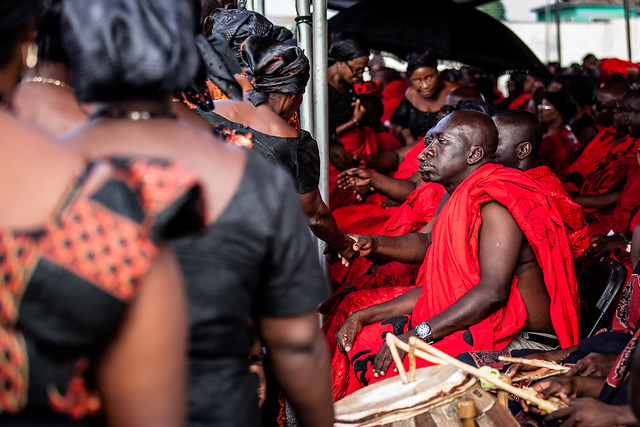
Yet in that location are positive aspects to these novel appearances of adinkra as individuals seek to have on cloths which are component of their heritage as well as thereby maintain the tradition active inwards a novel domain of appearance. There are also novel adinkra symbols added to the corpus of known stamps that go on the interplay betwixt the verbal declaration as well as the visual image. This attests to the dynamism of Akan lodge as they actively comprise the arts of the yesteryear to the present, changing appearance as well as utilisation to make an fine art shape suited to its time.
Bibliography
Antubam. K.,
1963 Ghana's Heritage of Culture.
Atkins, J.,
1737 Influenza A virus subtype H5N1 Voyage to Guinea, 2nd edition.
Bellis, J.,
1982 The 'place of the pots' inwards Akan Funerary Custom.
Bosman, W.,
1705 Influenza A virus subtype H5N1 New as well as Accurate Description of the Coast of Guinea, Reprinted 1907
Bowdich, T. E.,
1819 Mission from Cape Coast to Ashantee, Republished 1966.
Bravmann, R.,
1974 Islam as well as Tribal Art inwards West Africa.
1983 African Islam.
Cole, H. M. as well as Ross, D. H.,
1977 The Arts of Ghana.
Cruickshank, B.,
1853 Eighteen Years on the Gold Coast, Reprinted 1966.
De Marees, P.,
1604 Influenza A virus subtype H5N1 Description of the Golden Kingdom of Guinea. Translated Samuel Purchase inwards Purchase, His Pilgrims. Vol. 6, 1905.
Denteh, A. C.,
1975 "Ancient Burial Rituals of the Akan," Sankofa, no. 1.
Dupuis, J.,
1824 Journal of a Residence inwards Ashantee, Reprinted 1966.
Field, M. J.,
1948 Akim-Kotoko: An Sultanate of Oman of the Gold Coast.
MacDonald, G.,
1898 The Gold Coast—Past as well as Present: Influenza A virus subtype H5N1 Short Description of the Country as well as the People, Reprinted 1966.
Mato, D.,
1987 Clothed inwards Symbol—The Art of adinkra amidst the Akan of Ghana, Unpublished Ph.D. thesis, Indiana University.
McLeod, M. D.,
1976 "Verbal Elements inwards West African Art," Quaderni inwards Poro, I.
1981 The Asante.
Nketia, J. H. K.,
1955 Funeral Dirges of the Akan People.
Rattray, R. S.,
1916 Ashanti Proverbs, Reprinted 1969.
1927 Religion as well as Art inwards Ashanti, Reprinted 1969.
Silverman, R.,
1985 History, Art as well as Assimilation: The Impact of Islam on Akan Material Culture., Unpublished Ph.D. Thesis, University of Washington.
Wilks, I.,
1961 The Northern Factor inwards Ashanti History, Legon.
1961 "The Northern Factor inwards Ashanti History: Begho as well as the Mande," Journal of African History 2(1).
1971 "The Mossi as well as the Akan States 1500-1800," History of West Africa. ed. grand .Crowder as well as J. F. A. Ajayi.
1975 Asante inwards the Nineteenth Century.
Field interviews
Okyeame Nana Bafour Osei Akoto, Manhyia Palace, Kumasi, August 3, 1988.
Okyeame Nana Bafour Anti Boasiako, Manhyia Palace, Kumasi, August 2, 1988.
Nsumankwahene Nana Domfeh Gyeabor, Manhyia Palace, Kumasi, August 3, 1988.
Abanasehene Nana Asafo Agyi II, Manhyia Palace, Kumasi, July 16, 1992
Odikro (of Asokwa) Nana Kwasei Kroko, 1988, 1991, 1992.
Nana Kwaku Dua II, Tewobaabi, July 28, 1991
Nana Kwasei Tawiah, Ntonso, 1991, 1992.
Reverend Agyeman Duah, Kumasi, 1988, 1991, 1992.
Joseph Nsiah, at Ntonso, 1988, 1991, 1992.
Steven Appiah, Asokwa, 1982, 1988, 1991, 1992.
Kusi Kwame, Asokwa, 1982, 1988, 1991, 1992.
Appreciation to Dr. Steven Andoh, Secretary to the Asantehene, Manhyia Palace, Kumasi, for his assistance as well as advice during this study.



Comments
Post a Comment